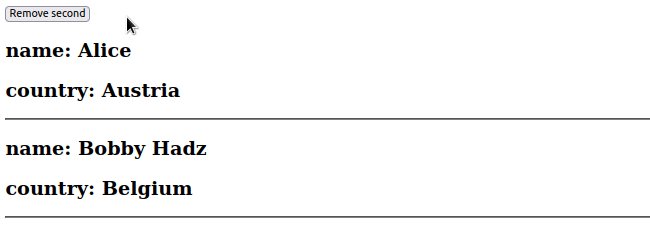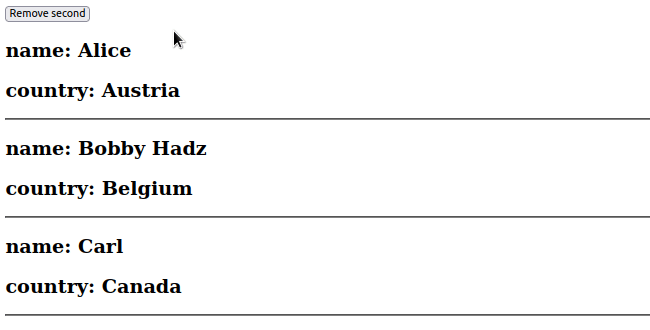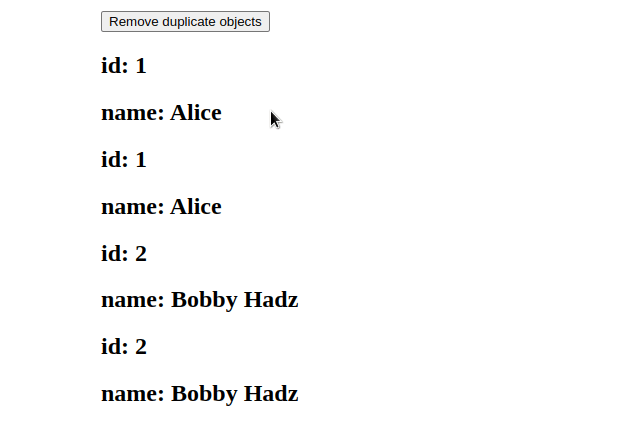Remove an Element from state Array in React
Last updated: Apr 7, 2024
Reading time·6 min

# Table of Contents
- Remove an element from state Array in React
- Never mutate the state array in place in React
- Remove elements from a state array based on multiple conditions
- Remove the Duplicates from a State array in React
- Remove the duplicate objects from a state array in React
# Remove an element from state Array in React
To remove an element from a state array in React:
- Use the
filter()method to iterate over the array. - On each iteration, check if a condition is met.
- Set the state to the new array that the
filtermethod returned.
import {useState} from 'react'; export default function App() { const initialState = [ {id: 1, name: 'Alice', country: 'Austria'}, {id: 2, name: 'Bobby Hadz', country: 'Belgium'}, ]; const [employees, setEmployees] = useState(initialState); const removeSecond = () => { setEmployees(current => current.filter(employee => { // 👇️ Remove the object that has an id equal to 2 return employee.id !== 2; }), ); }; return ( <div> <button onClick={removeSecond}>Remove second</button> {employees.map(({id, name, country}) => { return ( <div key={id}> <h2>name: {name}</h2> <h2>country: {country}</h2> <hr /> </div> ); })} </div> ); }

We initialized an employees state variable using the
useState hook.
The function we passed to the Array.filter() method gets called with each element in the array.
On each iteration, we check if the id property of the object is not equal to
2 and return the result.
const initialState = [ {id: 1, name: 'Alice', country: 'Austria'}, {id: 2, name: 'Bobby Hadz', country: 'Belgium'}, ]; const filtered = initialState.filter(obj => { // 👇️ Returns truthy for all elements that // Don't have an `id` equal to 2 return obj.id !== 2; }); // 👇️ [{id: 1, name: 'Alice', country: 'Austria'}] console.log(filtered);
The filter method returns a new array containing only the elements for which
the callback function returned a truthy value.
If the condition is never met, the Array.filter function returns an
empty array.
We passed a function to setState because the function is guaranteed to be
invoked with the current (most up-to-date) state.
const removeSecond = () => { // 👇️ current is the current state array setEmployees(current => current.filter(employee => { return employee.id !== 2; }), ); };
When the next state is computed using the previous state, pass a function to
setState.
# Never mutate the state array in place in React
You should never use functions like Array.pop() or Array.splice() to mutate
the state array in React.
const removeSecond = () => { const index = employees.findIndex(emp => emp.id === 2) // ⛔️ Don't do this employees.splice(index, 1) // ⛔️ Or this employees.pop() };
State objects and arrays are immutable. In order for React to keep track of changes, we need to set the state to a new array, rather than modifying the original array.
# Remove elements from a state array based on multiple conditions
If you need to remove an object from a state array based on multiple conditions, use the logical AND (&&) or logical OR (||) operators.
# Using the logical AND (&&) operator
The logical AND (&&) operator checks if multiple conditions are true.
const initialState = [ {id: 1, name: 'Alice', country: 'Austria'}, {id: 2, name: 'Bobby Hadz', country: 'Belgium'}, {id: 3, name: 'Carl', country: 'Austria'}, ]; const [employees, setEmployees] = useState(initialState); const remove = () => { setEmployees(current => current.filter(employee => { return employee.id !== 3 && employee.id !== 2; }), ); };
The logical AND (&&) operator only evaluates to true if both conditions are
true.
The callback function returns true only if the id property of the object is
not equal to 3 and not equal to 2.
# Using the logical OR (||) operator
The logical OR (||) operator checks if at least one of the conditions evaluate
to true.
const initialState = [ {id: 1, name: 'Alice', country: 'Austria'}, {id: 2, name: 'Bobby Hadz', country: 'Belgium'}, {id: 3, name: 'Carl', country: 'Austria'}, ]; const [employees, setEmployees] = useState(initialState); const remove = () => { setEmployees(current => current.filter(employee => { return employee.name === 'Alice' || employee.name === 'Carl'; }), ); };
Either of the 2 conditions has to evaluate to a truthy value for the element to be added to the new array.
In other words, if the name property on the object is equal to Alice or
equal to Carl, the object will be added to the new array. All other objects
are filtered out from the array.
I've also written an article on how to remove a key from a state object.
# Using both operators to remove an element from a state array
You can also use both operators if you have to check for multiple, complex conditions.
import {useState} from 'react'; export default function App() { const initialState = [ {id: 1, name: 'Alice', country: 'Austria'}, {id: 2, name: 'Bobby Hadz', country: 'Belgium'}, {id: 3, name: 'Carl', country: 'Canada'}, ]; const [employees, setEmployees] = useState(initialState); const remove = () => { setEmployees(current => current.filter(employee => { return ( (employee.name === 'Alice' || employee.name === 'Carl') && employee.country === 'Canada' ); }), ); }; return ( <div> <button onClick={remove}>Remove second</button> {employees.map(({id, name, country}) => { return ( <div key={id}> <h2>name: {name}</h2> <h2>country: {country}</h2> <hr /> </div> ); })} </div> ); }

The code in the parentheses uses the logical OR (||) operator to check if the
name property of the employee object is one of two values.
const remove = () => { setEmployees(current => current.filter(employee => { return ( (employee.name === 'Alice' || employee.name === 'Carl') && employee.country === 'Canada' ); }), ); };
If the condition is met, the logical AND (&&) operator checks if the country
property on the object is equal to Canada.
The expression in the parentheses has to evaluate to true and the condition on
the right-hand side has to evaluate to true for the object to be kept in the
state array.
If you need to remove a key from a state object, click on the link and follow the instructions.
# Remove the duplicates from a State array in React
To remove the duplicates from a state array:
- Use the
useState()hook to store the array in the state. - Use the
Set()constructor to remove the duplicates from the state array. - Update the state array to the new value.
import {useState} from 'react'; const App = () => { const words = ['bobby', 'bobby', 'hadz', 'hadz', 'com']; const [state, setState] = useState(words); const withoutDuplicates = [...new Set(words)]; // 👇️ ['bobby', 'hadz', 'com'] console.log(withoutDuplicates); const removeDuplicates = () => { setState(prevState => [...new Set(prevState)]); }; return ( <div> <button onClick={removeDuplicates}> Remove duplicates </button> {state.map((word, index) => { return ( <div key={index}> <h2>{word}</h2> </div> ); })} </div> ); }; export default App;

The parameter we passed to the Set constructor is an iterable - in our case an array.
const words = ['bobby', 'bobby', 'hadz', 'hadz', 'com']; // 👇️ {'bobby', 'hadz', 'com'} console.log(new Set(words)); const withoutDuplicates = [...words]; console.log(withoutDuplicates); // 👉️ ['bobby', 'hadz', 'com']
Set. However, the Set object can only store unique values, so all duplicates get automatically removed.The last step is to use the Spread operator (...) to unpack the values of the Set into a new array.
If you get the warning prop spreading is forbidden, click on the link and follow the instructions.
# Remove the duplicate objects from a state array in React
To remove the duplicate objects from a state array:
- Create an empty array that will store the unique object IDs.
- Use the
filter()method to iterate over the state array. - Check if the unique IDs array contains the ID of the current object.
- If the ID is contained, add the object's ID to the unique IDs array and the object to the state array.
import {useState} from 'react'; const App = () => { const employees = [ {id: 1, name: 'Alice'}, {id: 1, name: 'Alice'}, {id: 2, name: 'Bobby Hadz'}, {id: 2, name: 'Bobby Hadz'}, ]; const [state, setState] = useState(employees); const handleClick = () => { const uniqueIds = []; setState(currentState => { return currentState.filter(element => { const isDuplicate = uniqueIds.includes(element.id); if (!isDuplicate) { uniqueIds.push(element.id); return true; } return false; }); }); }; return ( <div> <button onClick={handleClick}> Remove duplicate objects </button> {state.map((employee, index) => { return ( <div key={index}> <h2>id: {employee.id}</h2> <h2>name: {employee.name}</h2> </div> ); })} </div> ); }; export default App;

The function we passed to the Array.filter() method gets called with each element (object) in the array.
const employees = [ {id: 1, name: 'Alice'}, {id: 1, name: 'Alice'}, {id: 2, name: 'Bobby Hadz'}, {id: 2, name: 'Bobby Hadz'}, ]; const uniqueIds = []; const uniqueEmployees = employees.filter(element => { const isDuplicate = uniqueIds.includes(element.id); if (!isDuplicate) { uniqueIds.push(element.id); return true; } return false; }); console.log(uniqueEmployees);
On each iteration, we check if the unique IDs array contains the ID of the current object.
If it does, we have a duplicate.
If it doesn't contain it, we need to add the ID to the unique IDs array and return a truthy value from the function.
filter method only adds an element to the results array if the function passed to the method returns a truthy value.The uniqueEmployees array doesn't contain any duplicates.
We used the id property as the object's identifier. However, in your case the
object's identifier might be called something else.
In essence, our solution is to:
- Only add unique IDs to the
uniqueIdsarray. - Only add the object to the results array if the object's ID is not in the
uniqueIdsarray.

